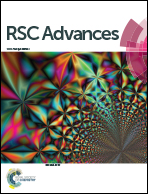Design, synthesis and antitumor activity of novel 8-substituted 2,3,5,6-tetrahydrobenzo[1,2-b:4,5-b′]difuran imidazolium salt derivatives†
Abstract
A series of novel 8-substituted 2,3,5,6-tetrahydrobenzo[1,2-b:4,5-b′]difuran imidazolium salt derivatives has been prepared and evaluated in vitro against a panel of human tumor cell lines. The results suggest that the existence of the 5,6-dimethyl-benzimidazole ring and substitution of the imidazolyl-3-position with a 2-naphthylmethyl or 4-methylbenzyl group were vital for modulating cytotoxic activity. Compound 43 was found to be the most potent derivative and exhibited cytotoxic activities selectively against breast carcinoma (MCF-7), colon carcinoma (SW480), myeloid leukaemia (HL-60) and lung carcinoma (A549) with an IC50 value 65.0-fold, 48.5-fold, 21.2-fold and 19.9-fold more sensitive to DDP, respectively.
![Graphical abstract: Design, synthesis and antitumor activity of novel 8-substituted 2,3,5,6-tetrahydrobenzo[1,2-b:4,5-b′]difuran imidazolium salt derivatives](/en/Image/Get?imageInfo.ImageType=GA&imageInfo.ImageIdentifier.ManuscriptID=C3RA43183E&imageInfo.ImageIdentifier.Year=2014)

 Please wait while we load your content...
Please wait while we load your content...